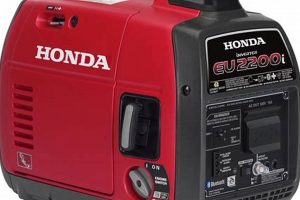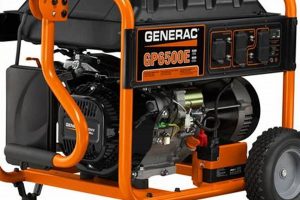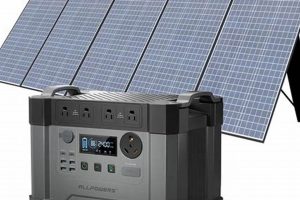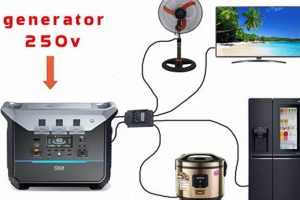Establishing a temporary power source involves connecting a compact generating unit to a residential structure, enabling essential appliances and systems to function during power outages. This typically includes positioning the generator outdoors in a well-ventilated area, connecting it to a transfer switch (for safe whole-house power) or directly to appliances using appropriately rated extension cords (for partial-house power), and following a specific starting procedure according to the manufacturer’s instructions. A representative example involves connecting a gasoline-powered generator to a transfer switch installed next to the main electrical panel, allowing specific circuits, such as lighting and refrigeration, to be powered during a utility outage.
Ensuring access to electricity during emergencies provides crucial safety and convenience. Critical systems like heating, cooling, refrigeration, medical devices, and communication systems can remain operational, safeguarding health and well-being. Historically, reliance on such localized power sources was commonplace before widespread grid connectivity. Modern implementations refine this legacy by leveraging technological advancements for increased efficiency and safety.
Understanding the intricacies of temporary power solutions necessitates exploring key topics. Proper generator selection, safe operation procedures, connection methods, maintenance requirements, and adherence to relevant regulations are essential considerations for successful implementation.
Tips for Portable Generator Setup
Proper setup is crucial for safe and effective generator operation. The following tips offer guidance for a successful installation.
Tip 1: Consult a qualified electrician. Professional guidance ensures compliance with local electrical codes and safe integration with home wiring.
Tip 2: Select the appropriate generator size. Calculate the wattage requirements of essential appliances and choose a generator that can handle the load. Consider future power needs as well.
Tip 3: Prioritize safety. Operate the generator outdoors in a well-ventilated area, away from windows and doors, to prevent carbon monoxide poisoning. Never refuel a hot generator.
Tip 4: Utilize a transfer switch. A transfer switch isolates the generator power from utility power, preventing backfeeding and protecting utility workers. Direct connection to appliances via extension cords should only power a limited number of devices and requires careful load management.
Tip 5: Ground the generator properly. Follow manufacturer instructions for grounding procedures to minimize electrical shock hazards.
Tip 6: Maintain the generator regularly. Perform routine maintenance, including oil changes, air filter cleaning, and spark plug replacement, according to the manufacturer’s recommendations. Test the generator periodically to ensure proper function during an outage.
Tip 7: Store fuel safely. Store fuel in approved containers in a well-ventilated area away from ignition sources. Rotate fuel stock to prevent degradation.
Adhering to these guidelines ensures a safe and reliable backup power source, minimizing risks and maximizing effectiveness during power disruptions. Proper planning and execution are essential for a successful installation.
By understanding the importance of each step, individuals can confidently prepare for power outages and ensure the continued operation of essential household systems.
1. Location
Generator placement significantly impacts safety and efficacy. Locating a generator too close to a structure poses fire and carbon monoxide poisoning risks. Open-air placement, away from windows, doors, and vents, minimizes these hazards. Prevailing winds should be considered to direct exhaust away from occupied areas. A stable, level surface ensures safe operation and prevents fuel spills. For example, placing a generator under a covered porch, while seemingly protected from weather, traps exhaust fumes, creating a dangerous environment. Conversely, positioning the generator a safe distance away, downwind from the house, mitigates these risks.
Practical considerations extend beyond immediate safety concerns. Accessibility for refueling and maintenance should be factored into location selection. Proximity to the area requiring power minimizes cable length, reducing voltage drop and improving efficiency. Excessive cable length can lead to power loss and overheating. For instance, powering appliances in a detached garage necessitates a location closer to the garage than the main house, optimizing power delivery. Careful planning ensures efficient energy transfer and ease of operation.
Appropriate generator placement optimizes safety and performance. Minimizing risks associated with exhaust fumes, fire hazards, and electrical distribution losses is crucial. Considering factors like wind direction, proximity to structures, and accessibility streamlines operation and maintenance. Strategic location selection is a foundational element of successful temporary power implementation.
2. Connections
Safe and reliable power delivery from a portable generator requires appropriate connection methods. Choosing the correct connection type and adhering to safety protocols are crucial for protecting both the home’s electrical system and individuals operating the equipment. Improper connections can lead to equipment damage, electrical hazards, and even fires. Understanding the various connection options and their implications is essential for successful generator integration.
- Transfer Switches
Transfer switches offer the safest and most convenient method for connecting a portable generator to a home’s electrical system. Installed by a qualified electrician, a transfer switch isolates the generator power from utility power, preventing backfeeding, a dangerous phenomenon that can harm utility workers and damage equipment. Transfer switches allow selective powering of specific circuits, ensuring critical systems receive power during an outage. For example, a homeowner might prioritize powering lights, refrigerators, and heating systems during a winter storm. This selective powering optimizes generator capacity and minimizes fuel consumption.
- Extension Cords
Direct connection to appliances via heavy-duty, outdoor-rated extension cords provides a simpler, albeit less comprehensive, power solution. This method is suitable for powering a limited number of essential devices. Careful load management is crucial; exceeding the generator or extension cord’s capacity can lead to overheating and potential fire hazards. For instance, connecting a refrigerator, a space heater, and several lights simultaneously might overload the system. Prioritizing essential loads and staggering usage can prevent overload situations. Understanding wattage requirements and adhering to manufacturer specifications is essential for safe operation.
- Inlet Boxes
An inlet box provides a dedicated connection point for the generator, offering a more permanent solution than extension cords while still allowing for manual connection and disconnection. This approach typically involves running a dedicated circuit from the inlet box to a subpanel or directly to critical appliances. Professional installation ensures compliance with electrical codes and optimizes power delivery. For example, an inlet box installed near a well pump allows convenient connection of the generator for maintaining water supply during outages.
- Generator Cords
Specialized generator cords, designed for outdoor use and high wattage transmission, facilitate secure connections between the generator and the transfer switch or inlet box. These cords incorporate features like twist-lock connectors to prevent accidental disconnection and weatherproof construction for enhanced durability. Using appropriately sized and rated cords is paramount for preventing voltage drop and overheating. Selecting a cord based on amperage and distance requirements ensures safe and efficient power transmission.
Correct connection procedures are paramount for safe and effective generator operation. Whether using a transfer switch, extension cords, an inlet box, or direct connection, adhering to safety guidelines, understanding load limitations, and selecting appropriate connection components ensure a reliable and hazard-free power supply during outages. By prioritizing safety and employing the correct connection strategy, homeowners can confidently utilize portable generators as a reliable backup power source.
3. Fueling
Proper fueling is a critical aspect of portable generator setup and operation. Incorrect fueling procedures can lead to equipment damage, hazardous conditions, and operational failures. Understanding fuel type, storage, and handling guidelines ensures safe and efficient generator performance. Neglecting these procedures can have serious consequences, impacting both the generator’s longevity and the user’s safety.
- Fuel Type
Generators operate on specific fuel types, typically gasoline, propane, or diesel. Using the incorrect fuel can damage the engine and create hazardous conditions. Gasoline generators are common for their portability and readily available fuel, while propane offers cleaner burning and longer storage life. Diesel generators provide greater efficiency and durability for extended operation. Consulting the manufacturer’s specifications is crucial for determining the correct fuel type for a specific generator model.
- Fuel Storage
Proper fuel storage is essential for maintaining fuel quality and preventing accidents. Fuel should be stored in approved containers, clearly labeled, and kept in a well-ventilated area away from ignition sources. Rotating fuel stock, using older fuel first, prevents degradation and ensures optimal generator performance. Gasoline, for example, can degrade over time, leading to starting difficulties and reduced engine efficiency. Storing fuel in a cool, dry place helps maintain its quality.
- Refueling Procedure
Safe refueling practices are paramount for preventing fires and other hazards. Always turn off the generator and allow it to cool completely before refueling. Avoid spilling fuel, and clean up any spills immediately. Never refuel a generator indoors or near open flames. Static electricity can ignite fuel vapors, so grounding the generator and fuel container during refueling minimizes this risk. These precautions mitigate the risk of fire and ensure safe operation.
- Fuel Level Monitoring
Regularly monitoring fuel levels prevents unexpected shutdowns and ensures uninterrupted operation. Running a generator out of fuel can damage the engine and connected appliances. Many generators feature built-in fuel gauges, while others require manual checks. Establishing a refueling schedule based on estimated run time and load requirements helps maintain consistent power delivery. For extended operations, having extra fuel readily available is essential.
Adhering to proper fueling procedures ensures the safe and reliable operation of a portable generator. Understanding fuel type, storage, refueling, and monitoring requirements is essential for maximizing generator performance and minimizing risks. By prioritizing safe fuel handling practices, individuals can confidently rely on their portable generators as a reliable backup power source.
4. Operation
Safe and efficient operation is the culmination of proper generator setup. A correctly installed generator, fueled appropriately, and connected safely is ready for operation. Starting procedures vary by model, but typically involve setting the choke, turning on the fuel valve, and engaging the starter. Allowing the generator to warm up before connecting loads stabilizes power output and protects connected equipment. Monitoring the generator during operation is crucial. Overloading the generator can lead to damage and power instability. Understanding the generator’s wattage capacity and managing connected loads accordingly prevents overload situations. For example, attempting to power a large air conditioner and multiple power tools simultaneously might exceed the generator’s capacity, leading to potential damage. Prioritizing essential loads and operating high-wattage appliances individually optimizes generator performance and safeguards connected devices. Appropriate operation ensures the generator’s longevity and reliable power delivery.
Operational considerations extend beyond simply starting and running the generator. Regular monitoring of oil levels, fuel consumption, and engine temperature safeguards against potential problems. Unusual noises, vibrations, or exhaust output indicate potential issues requiring immediate attention. Shutting down the generator safely involves disconnecting loads, turning off the fuel valve, and allowing the engine to cool before storage. These procedures prevent fuel leaks, protect connected equipment, and extend the generator’s lifespan. For instance, continuing to operate a generator with low oil levels can cause significant engine damage. Regular maintenance and adherence to recommended operational procedures are crucial for maintaining generator reliability and safety.
Successful generator operation is inextricably linked to proper setup. Careful attention to location, connections, fueling, and operational procedures ensures safe and reliable power delivery during outages. Understanding the generator’s capabilities, managing connected loads effectively, and adhering to manufacturer guidelines are essential for maximizing generator lifespan and ensuring consistent performance. Effective operation translates to a dependable backup power source, providing critical support during power disruptions.
5. Safety
Safety is paramount when setting up a portable generator for home use. Overlooking safety precautions can lead to severe consequences, including carbon monoxide poisoning, fire hazards, and electrical shocks. Careful consideration of location, ventilation, grounding, and connection procedures mitigates these risks. For example, operating a generator indoors or in a poorly ventilated area can cause a rapid buildup of carbon monoxide, a colorless, odorless, and deadly gas. Positioning the generator outdoors, away from windows and doors, and ensuring adequate ventilation is crucial for preventing carbon monoxide poisoning.
Electrical safety is another critical concern. Improper connections can lead to electrocution and fires. Using appropriately rated extension cords, ensuring proper grounding, and avoiding contact with water or wet surfaces minimize electrical hazards. Connecting a generator directly to household wiring without a properly installed transfer switch can cause backfeeding, energizing downed power lines and posing a lethal threat to utility workers. Professional installation of a transfer switch ensures safe isolation of generator power from utility lines, preventing backfeeding and protecting utility personnel.
Understanding and implementing safety protocols is essential for successful portable generator setup. Prioritizing proper ventilation, grounding, and connection procedures, as well as adhering to manufacturer guidelines, minimizes risks and ensures the safe operation of the generator. These measures protect individuals, property, and utility workers from potential harm. Safety is not merely a component of generator setup; it is the foundation upon which a reliable and effective backup power solution is built. Neglecting safety compromises the entire purpose of having a generator, turning a potentially life-saving device into a significant hazard.
Frequently Asked Questions
Addressing common inquiries regarding portable generator setup clarifies essential aspects and promotes safe and effective implementation. Understanding these frequently asked questions enhances preparedness and ensures reliable backup power during outages.
Question 1: What size generator is needed to power a typical home?
Generator sizing depends on the specific wattage requirements of the appliances one intends to operate. Calculating the combined wattage of essential appliances, such as refrigerators, sump pumps, and lighting, provides a baseline for generator selection. Consulting a qualified electrician can assist in accurately assessing power needs and selecting an appropriately sized generator.
Question 2: Is professional installation required for a portable generator?
While connecting a generator via extension cords for limited use does not typically require professional installation, connecting a generator to a home’s electrical system necessitates professional installation of a transfer switch. This ensures compliance with electrical codes and safeguards both the home’s electrical system and the utility grid.
Question 3: Where should a portable generator be placed during operation?
Generators should always be operated outdoors in a well-ventilated area, away from windows, doors, and vents. This placement minimizes the risk of carbon monoxide poisoning and ensures adequate airflow for proper engine cooling. Exhaust fumes should be directed away from occupied areas.
Question 4: What type of fuel is recommended for portable generators?
The recommended fuel type depends on the specific generator model. Common fuel types include gasoline, propane, and diesel. Consulting the manufacturer’s specifications is crucial for determining the correct fuel type and ensuring optimal generator performance and longevity. Using the incorrect fuel can damage the engine.
Question 5: How often should a portable generator be maintained?
Regular maintenance is essential for ensuring reliable generator operation. Maintenance schedules vary by model and usage, but typically include regular oil changes, air filter cleaning, and spark plug replacement. Consulting the manufacturer’s recommendations provides specific maintenance guidelines for a particular generator model.
Question 6: What safety precautions should be taken when operating a portable generator?
Several key safety precautions are essential for safe generator operation. Never refuel a hot generator. Ensure proper grounding to minimize electrical shock hazards. Avoid overloading the generator by managing connected loads carefully. Operate the generator in a dry location, away from water or wet surfaces. Always allow the generator to cool completely before storing it.
Understanding these frequently asked questions helps individuals make informed decisions regarding portable generator setup and operation. Prioritizing safety, adhering to manufacturer guidelines, and consulting qualified professionals when necessary ensures a reliable and effective backup power solution.
Exploring additional resources and seeking expert advice further enhances understanding and promotes safe and effective portable generator usage. Thorough preparation is essential for navigating power outages with confidence and minimizing disruption to daily life.
Conclusion
Establishing a reliable backup power source requires careful consideration of several key factors. Safe and effective portable generator setup involves selecting an appropriate location, ensuring proper connections, adhering to fueling guidelines, understanding operational procedures, and prioritizing safety at every step. Professional guidance is invaluable for integrating a generator into a home’s electrical system, ensuring compliance with electrical codes and safeguarding both the residence and utility infrastructure. Correct implementation transforms a portable generator from a simple machine into a critical resource, capable of maintaining essential services during power disruptions. Preparation, informed decision-making, and meticulous execution are essential for successful portable generator setup.
Portable generators represent a significant investment in preparedness and resilience. Proper setup maximizes their effectiveness, ensuring reliable performance when needed most. Understanding the intricacies of generator operation empowers individuals to navigate power outages safely and confidently, minimizing disruption and maintaining essential services. Continuous learning and adherence to evolving safety standards are crucial for maximizing the benefits and minimizing the risks associated with portable generator utilization. Investing in knowledge and preparation ensures that this valuable resource remains a source of security and stability, rather than an additional hazard during challenging circumstances.






